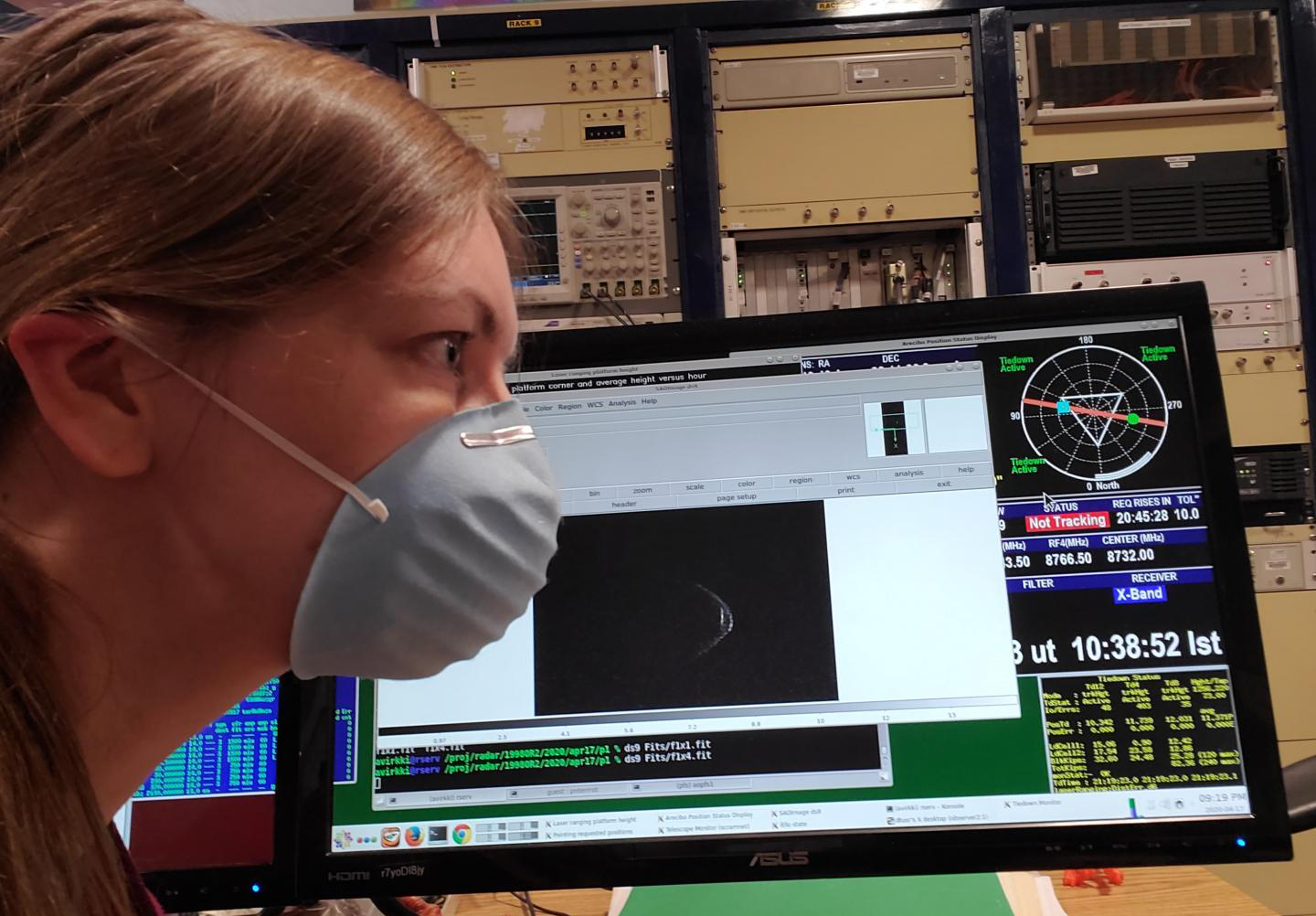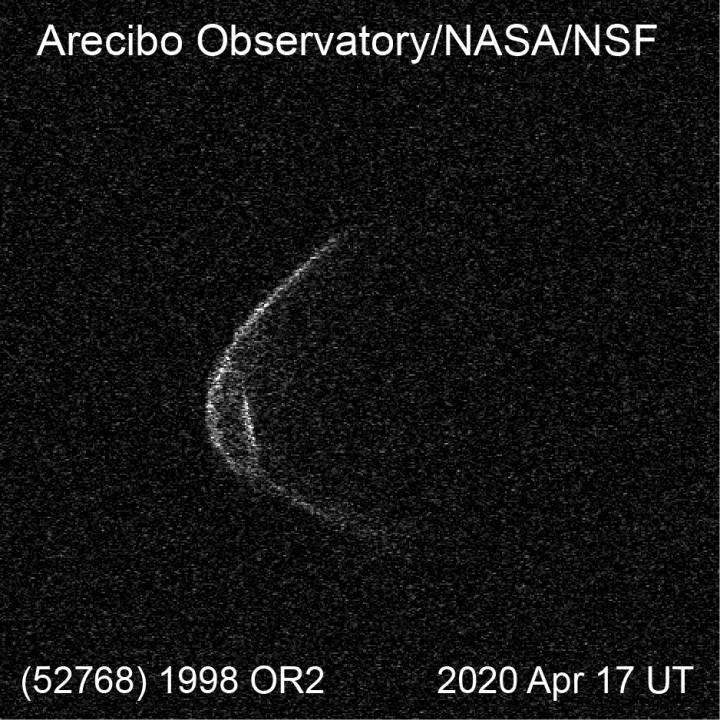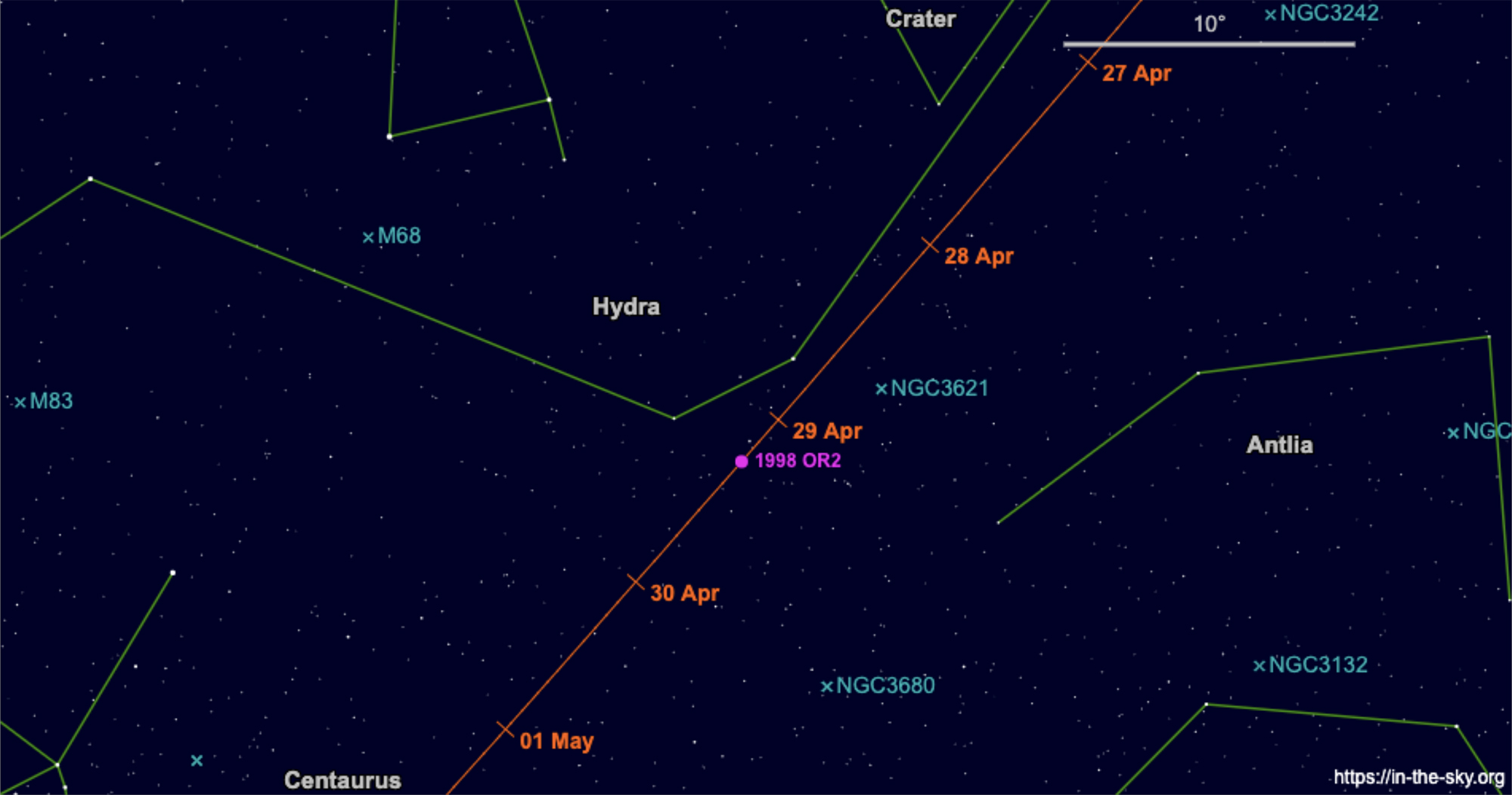Mile-long asteroid 1998 OR2 dons 'mask' before Earth flyby (photos)

The huge "potentially hazardous" asteroid 1998 OR2, which will safely fly by Earth on Wednesday (April 29), appears to have brought its own face mask for its close encounter with our pandemic-ridden planet.
Puerto Rico's Arecibo Observatory has been monitoring the asteroid's approach and recently released new images of the giant space rock, which "appears to know our planet is facing a pandemic," Arecibo Observatory officials said in a statement.
"The small-scale topographic features such as hills and ridges on one end of asteroid 1998 OR2 are fascinating scientifically," Anne Virkki, head of Planetary Radar at Arecibo Observatory, said in the statement. "But since we are all thinking about COVID-19 these features make it look like 1998 OR2 remembered to wear a mask."
Related: Big asteroid shows itself ahead of Earth flyby on April 29 (photo)
Due to the coronavirus pandemic, Arecibo astronomers have had to conduct most radio observations remotely. However, planetary radar observations require at least one radar operator and one scientist to be on site at the observatory. The limited staff present at the observatory are required to wear masks and follow other guidelines for preventing the spread of the novel coronavirus, which causes the respiratory disease COVID-19. (Puerto Rico has so far reported nearly 1,400 cases of COVID-19 and 84 deaths, according to Johns Hopkins University.)
Although it poses no threat to Earth during its flyby on Wednesday, asteroid 1998 OR2 is classified as a "potentially hazardous object" because it is a rather hefty space rock whose orbit intersects with Earth's orbit at a distance less than 4.6 million miles (7.5 million km), or 0.05 astronomical units, the average distance between Earth and the sun.

Using new imagery from the Arecibo Observatory, astronomers have estimated that asteroid 1998 OR2 has a diameter of approximately 1.2 miles (2 kilometers), or about as big as the National Mall in Washington, D.C. The imagery also revealed that the asteroid rotates about once every 4.1 hours.
Get the Space.com Newsletter
Breaking space news, the latest updates on rocket launches, skywatching events and more!
The asteroid will make its closest approach to Earth on Wednesday at approximately 5:56 a.m. EDT (0956 GMT), when it will be 3.9 million miles (6.3 million km) from Earth — or about 16 times the average distance between Earth and the moon.
While the asteroid currently poses no threat to Earth, observations by the Arecibo Observatory will allow scientists to more accurately predict the asteroid's future trajectory, which will sweep by Earth another 12 times this century, according to NASA. Only two of those approaches, in 2079 and 2127, will bring the asteroid closer to Earth than this year's flyby. The closest encounter will be on April 26, 2079, when asteroid 1998 OR2 will come within 1.1 million miles (1.8 million km) of Earth, or 4.6 times the average Earth-moon distance.
"The radar measurements allow us to know more precisely where the asteroid will be in the future, including its future close approaches to Earth," Flaviane Venditti, a research scientist at Arecibo Observatory, said in the statement. "In 2079, asteroid 1998 OR2 will pass Earth about 3.5 times closer than it will this year, so it is important to know its orbit precisely."
"Although this asteroid is not projected to impact Earth, it is important to understand the characteristics of these types of objects to improve impact-risk mitigation technologies," Virkki added.
How to see asteroid 1998 OR2

While observatories around the world will have an opportunity to catch a view of 1998 OR2, asteroid watchers can also catch live views of the encounter online by tuning into a free live webcast from Slooh on Tuesday (April 28) at 7 p.m. EDT (2300 GMT). The Virtual Telescope Project will also hold a free webcast on Wednesday (April 29) beginning at 2:30 p.m. EDT (1830 GMT).
The asteroid will also be visible in binoculars and small telescopes, weather permitting. It is currently shining at magnitude 11, which is too faint to see with the naked eye but bright enough for small telescopes or binoculars with a 70-80 millimeter aperture, according to The Sky Live. (Magnitude is a measurement of brightness used by astronomers, with lower numbers denoting brighter objects.) The image above shows the asteroid's path across the night sky from today (April 27) through Friday (May 1).
Editor's note: This article was updated on April 28 to reflect that The Virtual Telescope Project's live webcast of asteroid 1998 OR2 was rescheduled from April 28 to April 29 after clouds blocked the view during the first observing attempt. A newly announced Slooh webcast was also added.
- Coronavirus prevention measures take their toll on astronomy
- Asteroid defense: Scanning the sky for threats from space
- Potentially dangerous asteroids (images)
Email Hanneke Weitering at hweitering@space.com or follow her @hannekescience. Follow us on Twitter @Spacedotcom and on Facebook.
OFFER: Save 45% on 'All About Space' 'How it Works' and 'All About History'!
For a limited time, you can take out a digital subscription to any of our best-selling science magazines for just $2.38 per month, or 45% off the standard price for the first three months.
Join our Space Forums to keep talking space on the latest missions, night sky and more! And if you have a news tip, correction or comment, let us know at: community@space.com.

Hanneke Weitering is a multimedia journalist in the Pacific Northwest reporting on the future of aviation at FutureFlight.aero and Aviation International News and was previously the Editor for Spaceflight and Astronomy news here at Space.com. As an editor with over 10 years of experience in science journalism she has previously written for Scholastic Classroom Magazines, MedPage Today and The Joint Institute for Computational Sciences at Oak Ridge National Laboratory. After studying physics at the University of Tennessee in her hometown of Knoxville, she earned her graduate degree in Science, Health and Environmental Reporting (SHERP) from New York University. Hanneke joined the Space.com team in 2016 as a staff writer and producer, covering topics including spaceflight and astronomy. She currently lives in Seattle, home of the Space Needle, with her cat and two snakes. In her spare time, Hanneke enjoys exploring the Rocky Mountains, basking in nature and looking for dark skies to gaze at the cosmos.










